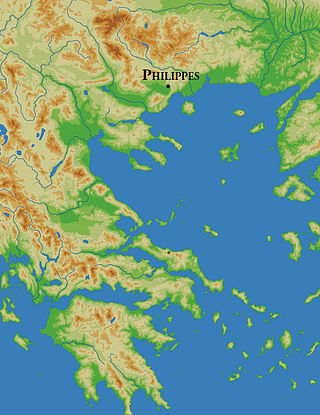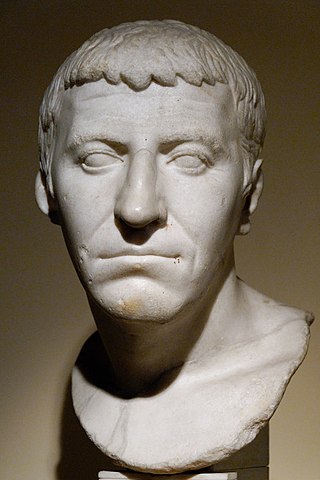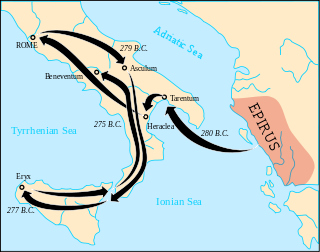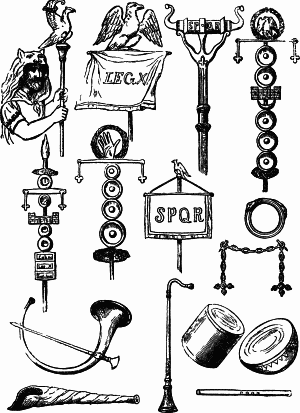
 |
| Part of a series on the |
| Military of ancient Rome |
|---|
In ancient Roman warfare, the testudo or tortoise formation was a type of shield wall formation commonly used by the Roman legions during battles, particularly sieges. [1]

 |
| Part of a series on the |
| Military of ancient Rome |
|---|
In ancient Roman warfare, the testudo or tortoise formation was a type of shield wall formation commonly used by the Roman legions during battles, particularly sieges. [1]
In the testudo formation, the men would align their shields to form a packed formation covered with shields on the front and top. [1] The first row of men, possibly excluding the men on the flanks, would hold their shields from about the height of their shins to their eyes, so as to cover the formation's front. The shields would be held in such a way that they presented a shield wall to all sides. The men in the back ranks would place their shields over their heads to protect the formation from above, balancing the shields on their helmets, overlapping them. If necessary, the legionaries on the sides and rear of the formation could stand sideways or backwards with shields held as the front rows, so as to protect the formation's sides and rear; this reduced the speed and mobility of the formation, but offered consistent defensive strength against opposing infantry and excellent protection against arrows and other missile attacks.
Plutarch describes this formation as used by Mark Antony during his invasion of Parthia in 36 BC:
Then the shield-bearers wheeled round and enclosed the light-armed troops within their ranks, dropped down to one knee, and held their shields out as a defensive barrier. The men behind them held their shields over the heads of the first rank, while the third rank did the same for the second rank. The resulting shape, which is a remarkable sight, looks very like a roof, and is the surest protection against arrows, which just glance off it. [2]
Cassius Dio writes about the testudo when describing the campaign of Mark Antony in 36 BC:
This testudo and the way in which it is formed are as follows. The Baggage animals, the light-armed troops, and the cavalry are placed in the center of the army. The heavy-armed troops who use the oblong, curved, cylindrical shields are drawn up around the outside, making a rectangular figure, and, facing outward and holding their arms at the ready, they enclose the rest. The others, who have flat shields, form a compact body in the center and raise their shields over the heads of all the others so that nothing but shields can be seen in every part of the phalanx alike and all the men by the density of the formation are under shelter from missiles. Indeed, it is so marvelously strong that men can walk upon it and whenever they come to a narrow ravine, even horses and vehicles can be driven over it.
The testudo was used to protect soldiers from all types of missiles. It could be formed by immobile troops and troops on the march. The primary drawback to the formation was that, because of its density, the men found it more difficult to fight in hand-to-hand combat and because the men were required to move in unison, speed was sacrificed. As "phoulkon", it played a great role in the tactics employed by the Byzantines against their eastern enemies.
The testudo was not invincible, as Cassius Dio also gives an account of a Roman shield array being defeated by Parthian cataphracts and horse archers at the Battle of Carrhae:
For if [the legionaries] decided to lock shields for the purpose of avoiding the arrows by the closeness of their array, the [cataphracts] were upon them with a rush, striking down some, and at least scattering the others; and if they extended their rank to avoid this, they would be struck with the arrows.
Tacitus recorded its use during the siege of the city of Cremona by the troops of Vespasian under command of Marcus Antonius Primus. During the attack the troops advanced under the rampart "holding their shields above their heads in close 'tortoise' formation". [3]
The testudo was a common formation in the Middle Ages, being used by Muhammad's forces during the Siege of Ta'if in 630, [4] also by the Carolingian Frankish soldiers of Louis the Pious to advance on the walls of Barcelona during the siege of 800–801, by Vikings during the siege of Paris in 885–886, by East Frankish soldiers under king Arnulf of Carinthia during the siege of Bergamo in 894, by Lotharingians under Conrad the Red at the siege of Senlis in 949, by Lotharingian defenders at the siege of Verdun in 984 and by the Crusaders of count Raymond IV of Toulouse during the siege of Nicaea in 1097. [5] [6] The testudo formation was again employed by medieval Arabs, who called it the dabbāba or "crawler". It was employed by Abu Abdallah al-Shi'i in the 906 siege of Tobna (in modern-day Algeria), where he used it to protect sappers as they advanced to the city walls, where they undermined and collapsed a tower, creating a breach for their allies to enter the city. [7]
During the Euromaidan protests in Kyiv, Ukraine in 2014 the Berkut riot police used the testudo tactic to protect themselves. [8]

The Battle of Philippi was the final battle in the Liberators' civil war between the forces of Mark Antony and Octavian and the leaders of Julius Caesar's assassination, Brutus and Cassius, in 42 BC, at Philippi in Macedonia. The Second Triumvirate declared the civil war ostensibly to avenge Julius Caesar's assassination in 44 BC, but the underlying cause was a long-brewing conflict between the so-called Optimates and the so-called Populares.

Gaius Cassius Longinus was a Roman senator and general best known as a leading instigator of the plot to assassinate Julius Caesar on 15 March 44 BC. He was the brother-in-law of Brutus, another leader of the conspiracy. He commanded troops with Brutus during the Battle of Philippi against the combined forces of Mark Antony and Octavian, Caesar's former supporters, and committed suicide after being defeated by Mark Antony.

A cataphract was a form of armored heavy cavalry that originated in Persia and was fielded in ancient warfare throughout Eurasia and Northern Africa.

The Battle of Carrhae was fought in 53 BC between the Roman Republic and the Parthian Empire near the ancient town of Carrhae. An invading force of seven legions of Roman heavy infantry under Marcus Licinius Crassus was lured into the desert and decisively defeated by a mixed cavalry army of heavy cataphracts and light horse archers led by the Parthian general Surena. On such flat terrain, the Legion proved to have no viable tactics against the highly-mobile Parthian horsemen, and the slow and vulnerable Roman formations were surrounded, exhausted by constant attacks, and eventually crushed. Crassus was killed along with the majority of his army. It is commonly seen as one of the earliest and most important battles between the Roman and Parthian Empires and one of the most crushing defeats in Roman history. According to the poet Ovid in Book 6 of his poem Fasti, the battle occurred on 9 June.

The scutum was a type of shield used among Italic peoples in antiquity, most notably by the army of ancient Rome starting about the fourth century BC.

The Battle of Asculum took place near Asculum in 279 BC between the Roman Republic under the command of the consuls Publius Decius Mus and Publius Sulpicius Saverrio, and the forces of King Pyrrhus of Epirus. The battle took place during the Pyrrhic War, after the Battle of Heraclea of 280 BC, which was the first battle of the war. There exist accounts of this battle by three ancient historians: Dionysius of Halicarnassus, Plutarch, and Cassius Dio. Asculum was in Lucanian territory, in southern Italy. The Battle of Asculum was the original “Pyrrhic victory”.

A shield wall is a military formation that was common in ancient and medieval warfare. There were many slight variations of this formation, but the common factor was soldiers standing shoulder to shoulder and holding their shields so that they would abut or overlap. Each soldier thus benefited from the protection of the shields of his neighbors and his own.

The Battle of Tigranocerta was fought on 6 October 69 BC between the forces of the Roman Republic and the army of the Kingdom of Armenia led by King Tigranes the Great. The Roman force, led by Consul Lucius Licinius Lucullus, defeated Tigranes, and as a result, captured Tigranes' capital city of Tigranocerta.
Testudo may refer to:

The Byzantine army evolved from that of the late Roman period taking as leading models and shaping itself on the late Hellenistic armies, but it became considerably more sophisticated in strategy, tactics and organization. The language of the army was still Latin, although later Greek dominated, as it became the official language of the entire empire. Unlike the Roman legions, its strength was in its cavalry, especially the armoured cataphracts, which evolved from the clibanarii of the late empire. Infantry were still used but mainly as a base of maneuver for the cavalry, as well as in specialized roles. Most of the foot-soldiers of the empire were the armoured skutatoi and later on, kontarioi, with the remainder being the light infantry and archers of the psiloi. The Byzantines valued intelligence and discipline in their soldiers far more than bravery or brawn. The "Ρωμαίοι στρατιώται"(rōmaíoi stratiōtai) were a loyal force composed of citizens willing to fight to defend their homes and their state to the death, augmented by mercenaries. The training was very much like that of the legionaries, with the soldiers taught close combat techniques with their swords, spears and axes, along with the extensive practice of archery.
Publius Ventidius was a Roman general and one of Julius Caesar's protégés. He won key victories against the Parthians which resulted in the deaths of key leaders – victories which redeemed the losses of Crassus and paved the way for Antony's incursions. According to Plutarch in his "Life of Antony", the three military victories of Ventidius over the Parthians singularly resulted in the only award to a Roman general of the triumphal ceremony for victory over Parthians.

Roman military personal equipment was produced in large numbers to established patterns, and used in an established manner. These standard patterns and uses were called the res militaris or disciplina. Its regular practice during the Roman Republic and Roman Empire led to military excellence and victory. The equipment gave the Romans a very distinct advantage over their barbarian enemies, especially so in the case of armour. This does not mean that every Roman soldier had better equipment than the richer men among his opponents. Roman equipment was not of a better quality than that used by the majority of Rome's adversaries. Other historians and writers have stated that the Roman army's need for large quantities of "mass produced" equipment after the so-called "Marian Reforms" and subsequent civil wars led to a decline in the quality of Roman equipment compared to the earlier Republican era:
The production of these kinds of helmets of Italic tradition decreased in quality because of the demands of equipping huge armies, especially during civil wars...The bad quality of these helmets is recorded by the sources describing how sometimes they were covered by wicker protections, like those of Pompeius' soldiers during the siege of Dyrrachium in 48 BC, which were seriously damaged by the missiles of Caesar's slingers and archers.
It would appear that armour quality suffered at times when mass production methods were being used to meet the increased demand which was very high the reduced size cuirasses would also have been quicker and cheaper to produce, which may have been a deciding factor at times of financial crisis, or where large bodies of men were required to be mobilized at short notice, possibly reflected in the poor-quality, mass produced iron helmets of Imperial Italic type C, as found, for example, in the River Po at Cremona, associated with the Civil Wars of AD 69 AD; Russell Robinson, 1975, 67
Up until then, the quality of helmets had been fairly consistent and the bowls well decorated and finished. However, after the Marian Reforms, with their resultant influx of the poorest citizens into the army, there must inevitably have been a massive demand for cheaper equipment, a situation which can only have been exacerbated by the Civil Wars...

For much of history, humans have used some form of cavalry for war and, as a result, cavalry tactics have evolved over time. Tactically, the main advantages of cavalry over infantry were greater mobility, a larger impact, and a higher riding position.

Quintus Labienus Parthicus was a Roman general in the Late Republic period. The son of Titus Labienus, he made an alliance with Parthia and invaded the Roman provinces in the eastern Mediterranean which were under the control of Mark Antony. He occupied the Roman province of Syria together with the Parthians in 40 BC. He then pushed into southern Anatolia, still with Parthian support. The main Parthian force took charge of Syria and invaded Judea. Both Labienus and the Parthians were defeated by Publius Ventidius Bassus, who recovered these provinces for Mark Antony.
The Hellenistic armies is a term that refers to the various armies of the successor kingdoms to the Hellenistic period, emerging soon after the death of Alexander the Great in 323 BCE, when the Macedonian empire was split between his successors, known as the Diadochi.
The Battle of Nisibis was fought in the summer of 217 between the armies of the Roman Empire under the newly ascended emperor Macrinus and the Parthian army of King Artabanus IV. It lasted for three days, and ended with a bloody Parthian victory, with both sides suffering large casualties. As a result of the battle, Macrinus was forced to seek peace, paying the Parthians a huge sum and abandoning the invasion of Mesopotamia that Caracalla had begun a year before.

Antony's Atropatene campaign, also known as Antony's Parthian campaign, was a military campaign by Mark Antony, the eastern triumvir of the Roman Republic, against the Parthian Empire under Phraates IV.

The Tactica is a military treatise written by or on behalf of Byzantine Emperor Leo VI the Wise in c. 895–908, and later edited by his son, Constantine VII. Drawing on earlier authors such as Aelian, Onasander and the Strategikon of emperor Maurice, it is one of the major works on Byzantine military tactics, written on the eve of Byzantium's "age of reconquest". The original Greek title is τῶν ἐν πολέμοις τακτικῶν σύντομος παράδοσις. The Tactica elaborates on a wide variety of issues, such as infantry and cavalry formations, drills, siege and naval warfare etc. It is written in a legislative form of language and comprises 20 Constitutions and an Epilogue and is concluded by 12 additional chapters, the latter mainly focusing on ancient tactics.
The phoulkon, in Latin fulcum, was an infantry formation utilized by the military of the late Roman and Byzantine Empire. It is a formation in which an infantry formation closes ranks and the first two or three lines form a shield wall while those behind them hurl projectiles. It was used in both offensive and defensive stances.
Antony's campaign against Armenia occurred in 34 BCE as retaliation for Armenian cavalry deserting Mark Antony against Parthia. Antony thus set out to conquer Armenia.
A modern reconstruction of Roman soldiers in the testudo (tortoise) formation.